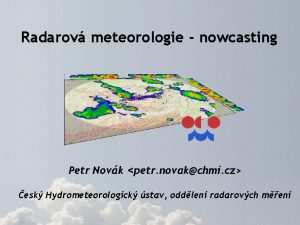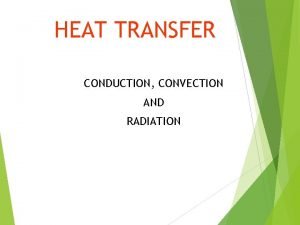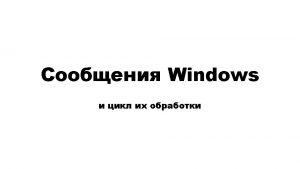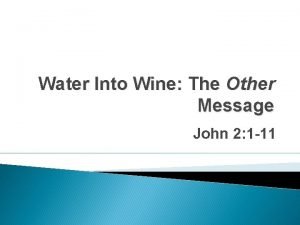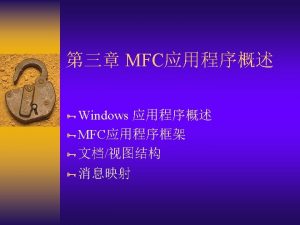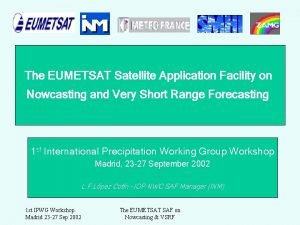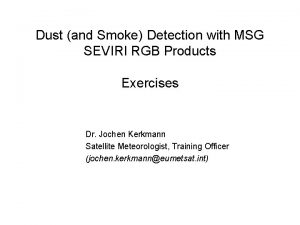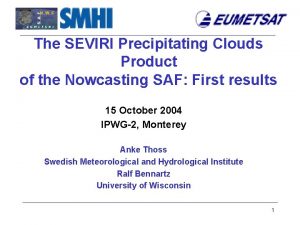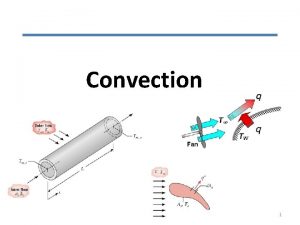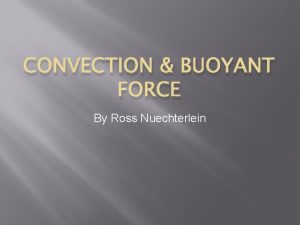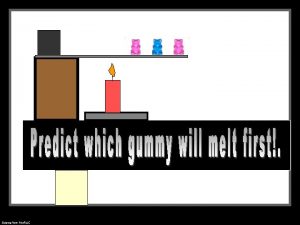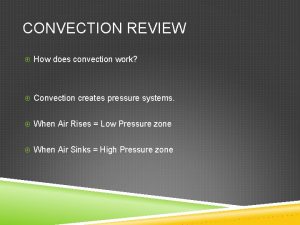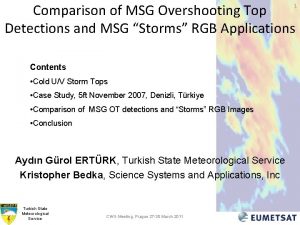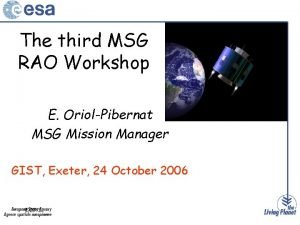UWCIMSSUAH MSG SEVIRI Convection Diagnostic and Nowcasting Products











- Slides: 11

UW-CIMSS/UAH MSG SEVIRI Convection Diagnostic and Nowcasting Products Wayne F. Feltz 1, Kristopher M. Bedka 1, and John R. Mecikalski 2 1 Cooperative Institute for Meteorological Satellite Studies (CIMSS), UW-Madison 2 University of Alabama in Huntsville (UAH) Talk Given By David Turner, University of Wisconsin-Madison

UW-CIMSS Interest and Involvement with COPS UW-CIMSS, in collaboration with UAH, have developed a suite of satellite-derived convection diagnostic and nowcasting products (primarily for the aviation community) - Primary goal is to objectively identify rapid convective storm development using satellite imagery before a significant signal is observed by weather radar GOES-12 products are being tested within aviation turbulence and convective storm nowcast systems developed by the U. S. Federal Aviation Administration As part of GOES-R Advanced Baseline Imager (ABI) Risk Reduction efforts, UW-CIMSS has produced these products over the COPS domain using MSG SEVIRI for the full duration of the experiment MSG SEVIRI products are being evaluated by EUMETSAT and the South African Weather Service

UW-CIMSS Interest and Involvement with COPS UW-CIMSS goals for COPS datasets are to use SEVIRI to: 1) Demonstrate product improvement that will be generated through better spatial, spectral, and temporal resolution of the future GOES-R ABI (SEVIRI shares many spectral channels with ABI, SEVIRI was in 5 -min scan mode during COPS) 2) Monitor relationships between cloud top cooling/microphysical changes, precipitation, and cloud electrification 3) Development of objective satellite storm severity estimates (i. e. overshooting top, enhanced-V signatures) 4) Development of nocturnal convection nowcast products

Online COPS Product Quicklooks http: //cimss. ssec. wisc. edu/snaap/cops/quicklooks. php Product Suite Includes 1) Objective Cumulus Cloud Classification 2) Cloud Top Temperature Trends Using 2 Different Methods (Box-averaging and AMV-based cloud tracking) 3) Convective Initiation Nowcast 4) Mesoscale Satellitederived Winds

Why Are Satellite-Derived Cloud Top Temperature Trends Important? Rapid cumulus cloud growth coupled with a temperature drop below 0° C in satellite IR imagery can precede significant radar echoes (~35 d. BZ) by 30 -45 minutes From GOES-12 and SEVIRI, UW-CIMSS/UAH products can objectively identify rapidly growing cumulus that are likely to evolve into deep convective storms Roberts and Rutledge (WAF, 2003)

Cloud Top Temperature Trends Using Rapid -Scan COPS Imagery 5 -minute IR cloud top temperature trends are accumulated for 3 hours to show regions of convective storm initiation and development The largest temperature decreases over the 3 hour period correspond to locations of rapid convective initiation and development Convective initiation was well captured over the COPS region, in addition to numerous other locations within the scene

Animation of Accumulated Cloud Top Temperature Trends

Accumulated IR Window Temperature Change: 1145 -1230 UTC Past Accumulated Temperature Change With Future Lightning (1230 -1300 UTC) NEW CONVECTIVE INITIATION Lesotho Free State South Africa

Product Applications and Future Plans UW-CIMSS plans to continue using rapid-scan SEVIRI imagery from COPS in preparation for the future GOES-R ABI instrument • We have a critical need for radar and lightning validation datasets to aid in product development and performance evaluation The entire suite of products from the COPS experiment are available in Net. CDF format, see contact info below COPS scientists can apply these products toward: 1) Recognition of initial signals of convective initiation before precipitation is evident in weather radar 2) Assimilation of convective classification and cloud growth into mesoscale NWP models to improve precipitation forecasting 3) Assimilation of mesoscale satellite winds to improve NWP initialization Please contact us with any questions or interest in collaboration! CONTACT INFORMATION: Wayne Feltz: waynef@ssec. wisc. edu Kristopher Bedka: krisb@ssec. wisc. edu


Why Are Satellite-Derived Cloud Top Temperature Trends Important? Rapid cumulus cloud growth coupled with a temperature drop below 0° C in satellite IR imagery can precede significant radar echoes (~35 d. BZ) by 30 -45 minutes From GOES-12 and SEVIRI, UW-CIMSS/UAH products can objectively identify rapidly growing cumulus that are likely to evolve into deep convective storms Convective cloud IR window temperatures are averaged over. 3 degree boxes and the mean is differenced over time to identify areas of rapid cooling without having to explicitly track each cumulus cloud pixel or object PRODUCTS ARE CURRENTLY DAYTIME ONLY AS VISIBLE IMAGERY IS USED IN CUMULUS CLASSIFICATION Roberts and Rutledge (WAF, 2003)
